SCROG vs SOG: What Is Better For Your Autoflowers?
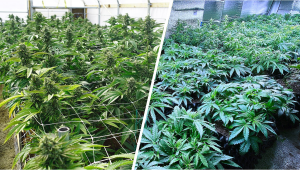
When growing cannabis, you have a wide range of training methods to choose from. Although they involve many different methods, they all achieve similar results. Ultimately, training aims to improve airflow and minimize the risk of mold in the canopy. The improved structure that results from these techniques also helps to improve light penetration and exposure to buds slightly lower down. Of course, the ultimate reason for employing cannabis training techniques during the growing cycle boils down to productivity and increased yields. By simply tying down, cutting, and trellising plants, you can vastly increase the amount of resinous buds that you receive when harvesting time swings around.
Scrog vs Sog is one of the most asked questions by many growers indoors. These are two different techniques that even being so different both give a solution to the same problem: to increase cannabis yields and quality per crop.
Despite their inherent differences, both techniques achieve the same result: More yield per square meter. These methods come in particularly handy in small indoor spaces that can otherwise only house 1–2 plants grown using traditional approaches. Both SCROG and SOG enable growers to raise a large number of plants because they keep specimens small and under control. However, cannabis growers can also use both methods on a larger scale to increase production in large grow rooms or greenhouses.
1. What is SCROG and SOG?
SCROG and SOG are both low stress training (LST) techniques used to control the growth of cannabis plants. This is done by creating a horizontal even canopy, this ensures all bud sites receive light uniformly and grow at the same rate. Usually, the lower branches can’t absorb much light and don’t develop well. These techniques were created to focus on the top part of the plant, producing big colas and denser buds in less time. Instead of growing vertically upwards and developing one large central cola, these plants are weaved into a single trellis, forcing them to grow laterally instead. This does away with a large primary bud and instead diverts energy into many slightly smaller but evenly-sized flowers. Not only does this boost overall yields, but it removes the risk that central colas bring. These exceptionally large buds are certainly pleasing to the eye, but their incredible density makes them very susceptible to mold—especially in more humid environments.
However, both SCROG and SOG don’t only offer enhanced yields. These methods also create a favorable shape that helps plants make the most of a very important resource: Light. Tall and untrained cannabis plants cast shadows over buds and fan leaves in the lower portions of the canopy. In contrast, SCROG and SOG create a uniform and flat canopy that evens out light distribution to bud sites and leaves.
Additionally, SCROG and SOG can also help to mitigate disease. Fungal pathogens pose a threat to many indoor growing operations and manage to gain a foothold when conditions are humid and stagnant. By creating a flat canopy, growers create channels for air to flow unobstructed above and below bud sites. Ultimately, this helps to reduce moisture and lower instances of mold formation.
2. SCROG
The Screen of Green (aka SCROG) is a type of low stress training involving a net screen between the growing lights and pots and little bit of plant training.
In this method, the cannabis plant will eventually grow up to the net screen and with a bit of training achieve the desired objective. The training needed after they reach the net is relatively easy, you just need to push the branches that have outgrown the net back down, this will make the branches grow horizontally and slowly create a large and even canopy.
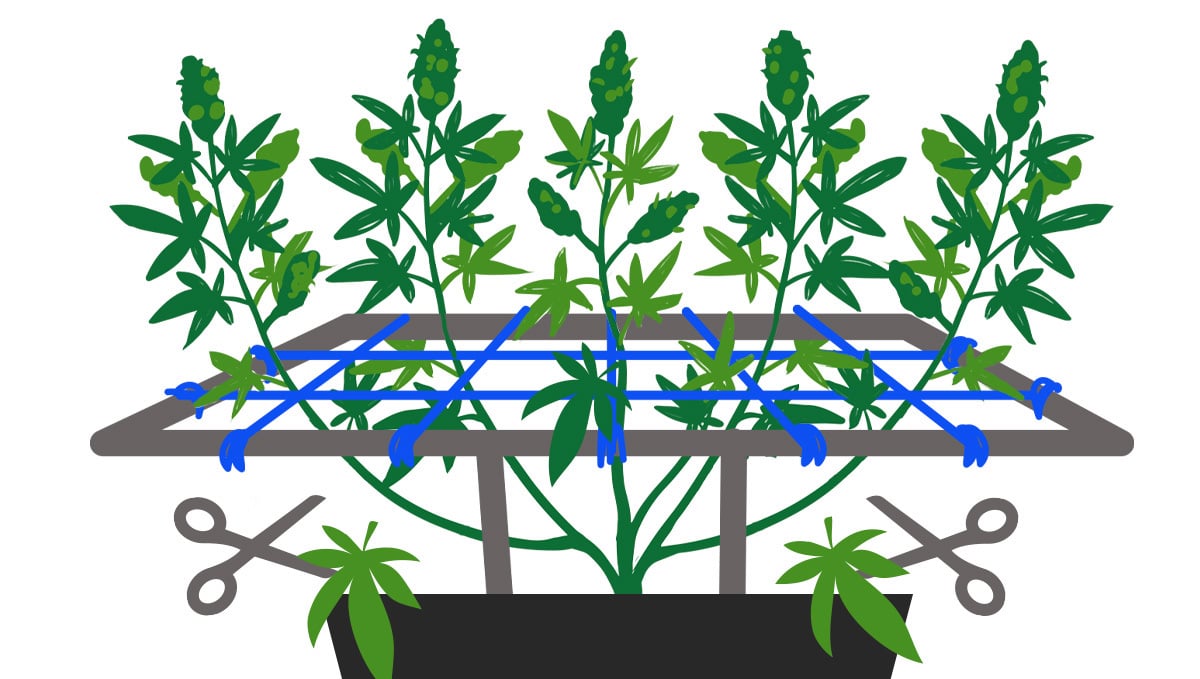
This is an excellent way to take full advantage of the area covered by your lights, by training your plants into a spread-out canopy you allow multiple bud sites to develop to their full potential instead of one large one at the top. As you can see from the image above, the net serves to separate branches from each other. As opposed to staking or tying up individual branches, growers simply thread them through a net as an easier alternative. This technique works extremely well in a small grow tent or outdoor space. However, there are no real limits to how big you can make a scrog net, and how many plants you can include.
Of course, you’ll always need to be able to reach the middle branches to maintain them—so keep this in mind if you fancy creating a much larger SCROG setup. Once the canopy is established, most growers prune all the lower growth as they are in the shadow of the canopy thus not getting light, this way you avoid wasted energy.
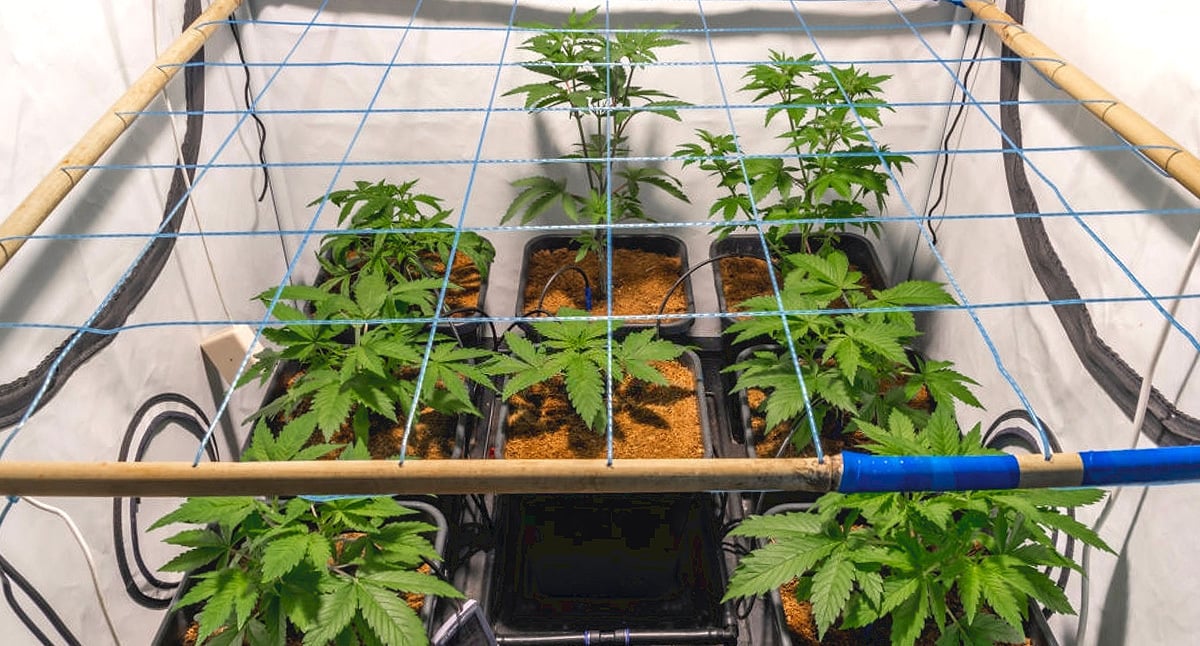
An important factor to take into account when using the SCROG technique is the strains being used. Depending on the genetics, cannabis plants can react differently when switched over to a flowering photoperiod, some will stretch and rapidly fill out while others won’t. This is a good method if you want to make the most out of every seed, generally using 1 plant per 30 cm of net.
The main difference between SCROG and SOG is that in the Screen of Green you will use way fewer plants to fill the canopy than in the Sea of Green.
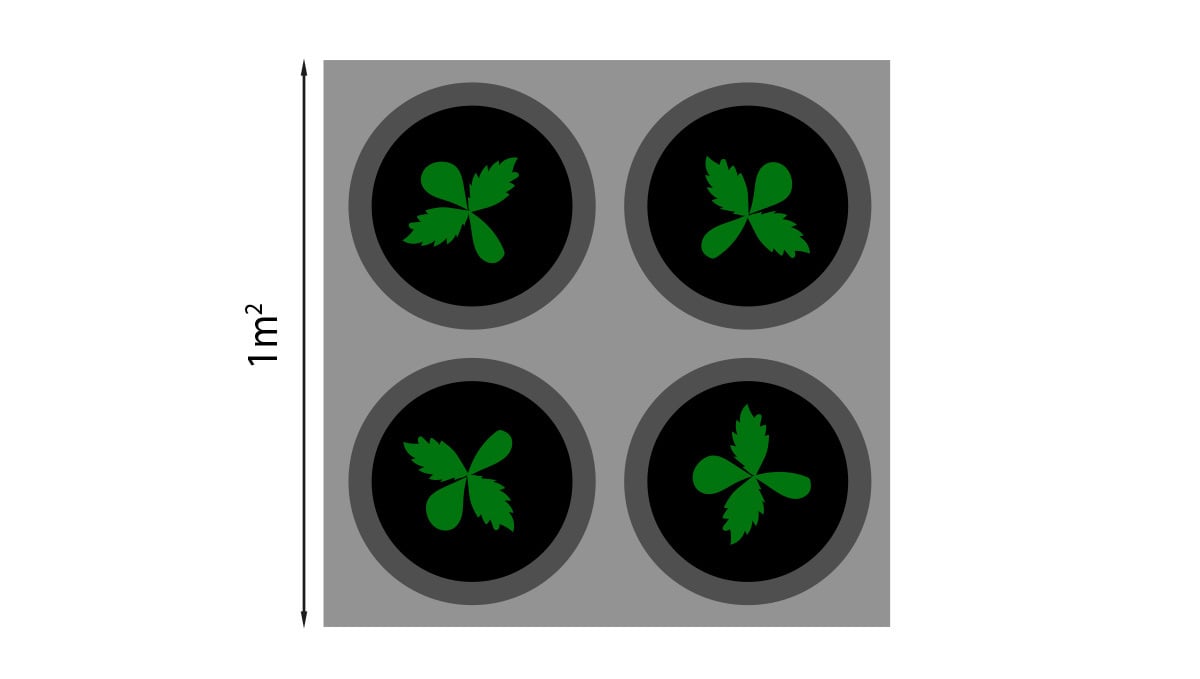
Where in SCROG you may need up to 4 plants per m², in a SOG you can have 12 or more per m², depending on the type of strain.
Pros:
• It can be done with cuttings and seeds.
• Offers multiple bud sites from only a few plants.
• Low maintenance as you only have a few plants to take care of.
Cons:
• Takes longer than SOG.
3. SOG
The Sea of Green (aka SOG) is especially used in small grow spaces or when you want to grow your plants really fast and you can (or not) use a net to help you maintain the plants short.
Where the SCROG technique focuses on producing multiple bud sites, the Sea of Green technique does the opposite, forcing the cannabis plant to put all its energy into one main cola.
Unlike SCROG, the SOG technique is recommended to be done with autoflowers or clones.
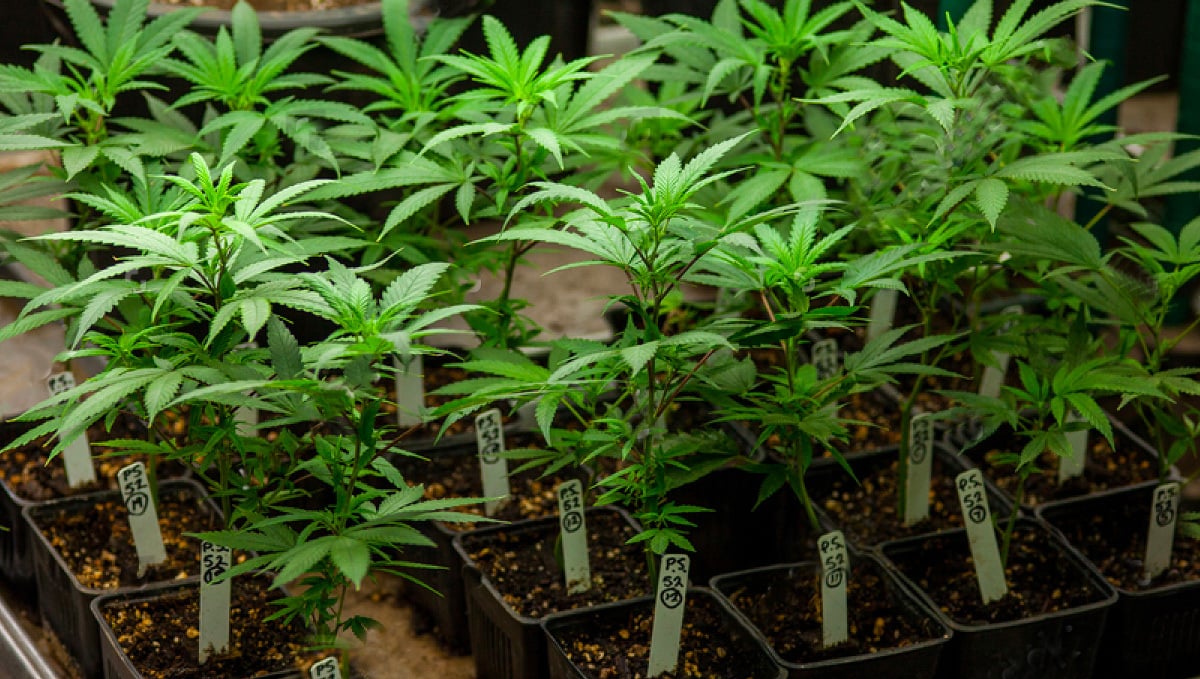
To grow in a Sea of Green, plants are packed into a tight space reaching up to 40 or more per square meter.
Even though there are strains that may take more time, after giving around 2 weeks for clones you should switch to a flowering cycle so they can flower while still being short, producing a thick stem and branches.
This growing method does not require pruning or trimming as long as you have proper airflow. When growing a large number of plants together it is recommended to add fans to not only strengthen the stems to allow your plants to not fold down but also reduce the risk of pests and diseases.
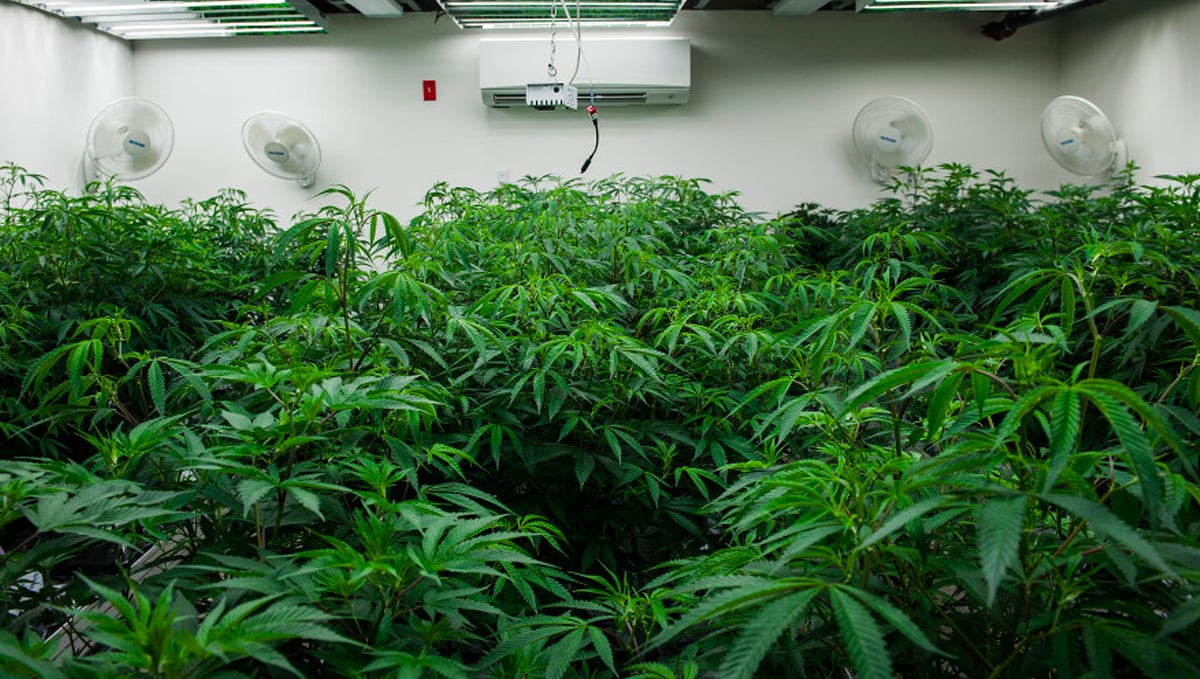
For autoflowers it is recommended to use a net, after 3-5 weeks of growth and slight training the net should be completely filled and ready for the production of flowers. There are strains that are better well suited for this kind of grow method, generally, Indicas tend to be most suited to this. Plants should rarely grow beyond 30cm tall using this method, so all energy is in the main cola.
The way plants need to grow in this method is why you use clones or autos, feminized plants grown from seed will still grow high before they can start flowering.
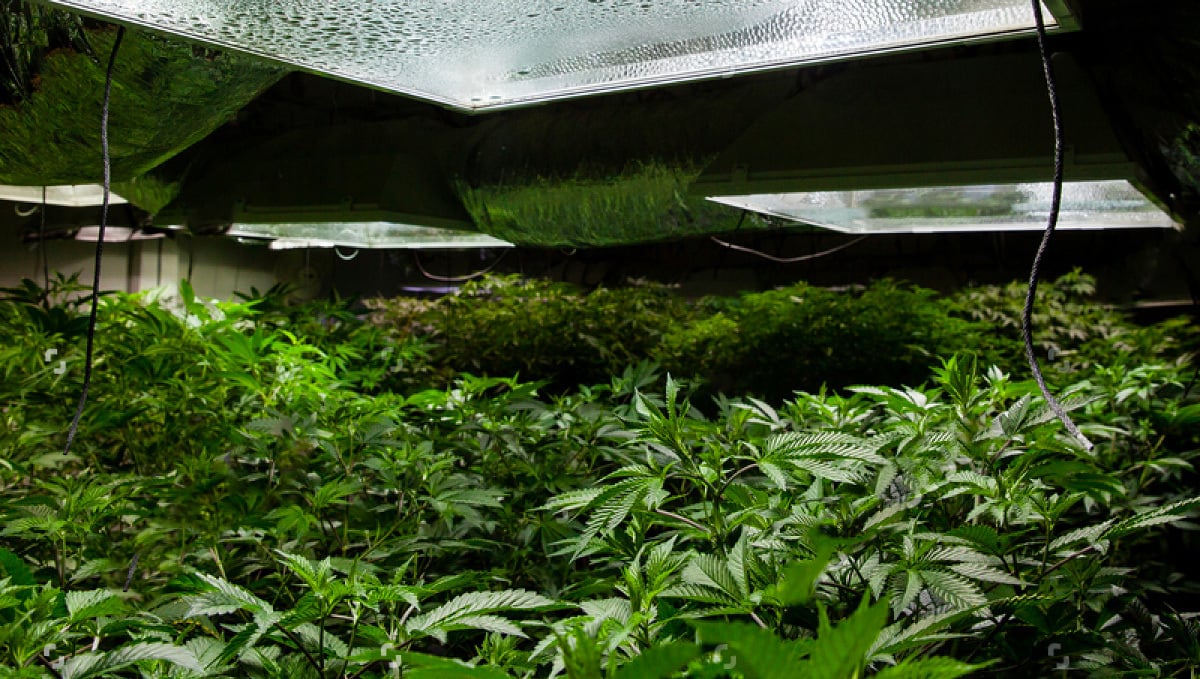
Pros:
• Very fast growing time.
• Great for small grow spaces.
• Faster than SCROG.
Cons:
• High maintenance.
• A lot of plant material means a higher chance of pests.
4. Which Technique Is Better For Autoflowers?
As we all know, autoflowers don’t take too well training and even LST can shock them if not done properly and even though it is possible to perform SCROG with autos, it is not recommended.
Most autos don’t grow as much as photoperiodic cannabis and it can be really difficult to trim unwanted growth without encountering a lot of problems, that’s why SOG is highly recommended for autoflowers.
It’s better to grow Indica-dominant strains in SOG, we recommend our Girls Scout Cookies Auto as she will naturally grow shorter and if done correctly you can harvest up to 15-20 plants per square meter, resulting in a huge yield per cycle.
Sea of green is considered one of the most efficient methods for harvesting buds from autos as soon as possible. It does not require the training and extended growth time that it takes to grow plants using the screen of green (SCROG) cultivation method. And if you choose proper strains, you can save time and space.
If you want to use a SCROG method on your autoflower, Wedding Cheesecake Auto will be the best option as she performs extremely well under Screen of Green.
Generally, autos grow up to 80cm and need around 3-4 weeks to start flowering, these characteristics that make them unique also make them perfect for growing in SOG especially if you are using a net to control height.
5. In Conclusion
SCROG and SOG are techniques with similar objectives, they help you grow the best quality and yields while making the most out of your lights, grow space, and plants.
If you’re interested in trying them out, have in consideration that the strain you use can deeply affect your final result, try to grow the same strain because if you choose different strains it can get really difficult to train them equally. Smaller indica-dominant varieties are easier to manage and stretch less during the flowering stage. Of course, if you go down the SOG route, autoflowering varieties will provide the best option because of their compact size, rapid growing times, and general hardiness.
Even though it may seem hard, these are one of the simplest techniques with the tips given in this article, and a little bit of experimenting even an unexperienced grower will be able to perform them successfully.








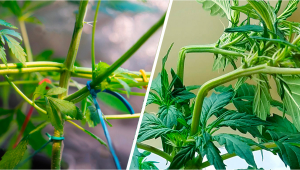


Comments